Report on Understanding and Leading Change at Waitrose & Partners
VerifiedAdded on 2021/02/21
|19
|6454
|415
Report
AI Summary
This report provides a comprehensive analysis of change management and leadership within Waitrose & Partners. It begins by examining the impact of organizational change on the company's strategy and operations, comparing its approach to that of Poundland. The report then delves into the internal and external drivers of change, focusing on how these factors influence leadership, team dynamics, and individual behaviors. A SWOT and PEST analysis is used to illustrate these drivers. The report also explores measures to minimize the negative impacts of change on organizational behavior. Furthermore, it addresses the barriers to change and their influence on leadership decision-making, employing force field analysis to evaluate driving and resisting forces. Finally, the report assesses different leadership approaches to dealing with change, evaluating their effectiveness using relevant models and frameworks. The conclusion summarizes key findings and offers recommendations for effective change management planning and implementation.
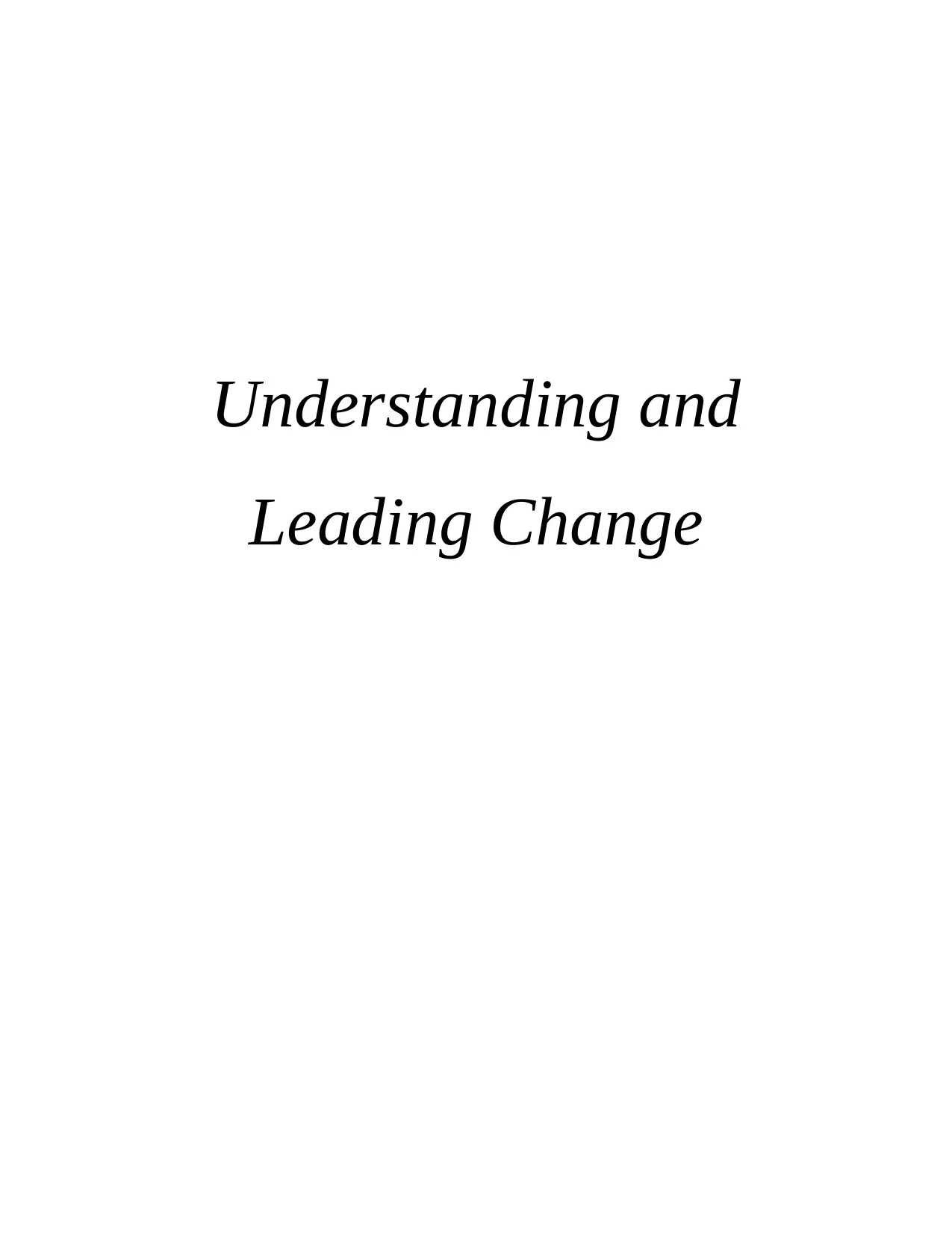
Understanding and
Leading Change
Leading Change
Paraphrase This Document
Need a fresh take? Get an instant paraphrase of this document with our AI Paraphraser
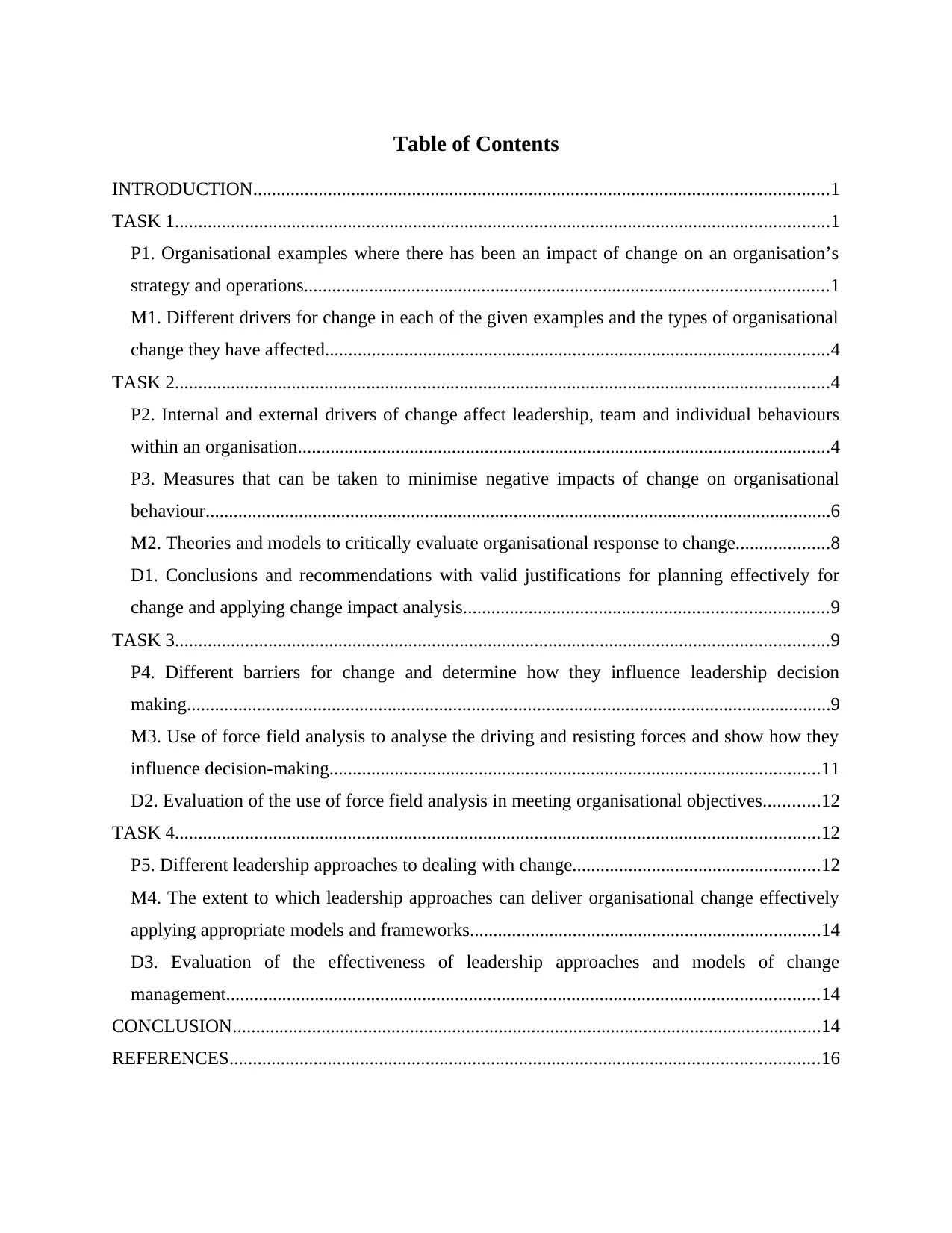
Table of Contents
INTRODUCTION...........................................................................................................................1
TASK 1............................................................................................................................................1
P1. Organisational examples where there has been an impact of change on an organisation’s
strategy and operations................................................................................................................1
M1. Different drivers for change in each of the given examples and the types of organisational
change they have affected............................................................................................................4
TASK 2............................................................................................................................................4
P2. Internal and external drivers of change affect leadership, team and individual behaviours
within an organisation..................................................................................................................4
P3. Measures that can be taken to minimise negative impacts of change on organisational
behaviour......................................................................................................................................6
M2. Theories and models to critically evaluate organisational response to change....................8
D1. Conclusions and recommendations with valid justifications for planning effectively for
change and applying change impact analysis..............................................................................9
TASK 3............................................................................................................................................9
P4. Different barriers for change and determine how they influence leadership decision
making..........................................................................................................................................9
M3. Use of force field analysis to analyse the driving and resisting forces and show how they
influence decision-making.........................................................................................................11
D2. Evaluation of the use of force field analysis in meeting organisational objectives............12
TASK 4..........................................................................................................................................12
P5. Different leadership approaches to dealing with change.....................................................12
M4. The extent to which leadership approaches can deliver organisational change effectively
applying appropriate models and frameworks...........................................................................14
D3. Evaluation of the effectiveness of leadership approaches and models of change
management...............................................................................................................................14
CONCLUSION..............................................................................................................................14
REFERENCES..............................................................................................................................16
INTRODUCTION...........................................................................................................................1
TASK 1............................................................................................................................................1
P1. Organisational examples where there has been an impact of change on an organisation’s
strategy and operations................................................................................................................1
M1. Different drivers for change in each of the given examples and the types of organisational
change they have affected............................................................................................................4
TASK 2............................................................................................................................................4
P2. Internal and external drivers of change affect leadership, team and individual behaviours
within an organisation..................................................................................................................4
P3. Measures that can be taken to minimise negative impacts of change on organisational
behaviour......................................................................................................................................6
M2. Theories and models to critically evaluate organisational response to change....................8
D1. Conclusions and recommendations with valid justifications for planning effectively for
change and applying change impact analysis..............................................................................9
TASK 3............................................................................................................................................9
P4. Different barriers for change and determine how they influence leadership decision
making..........................................................................................................................................9
M3. Use of force field analysis to analyse the driving and resisting forces and show how they
influence decision-making.........................................................................................................11
D2. Evaluation of the use of force field analysis in meeting organisational objectives............12
TASK 4..........................................................................................................................................12
P5. Different leadership approaches to dealing with change.....................................................12
M4. The extent to which leadership approaches can deliver organisational change effectively
applying appropriate models and frameworks...........................................................................14
D3. Evaluation of the effectiveness of leadership approaches and models of change
management...............................................................................................................................14
CONCLUSION..............................................................................................................................14
REFERENCES..............................................................................................................................16
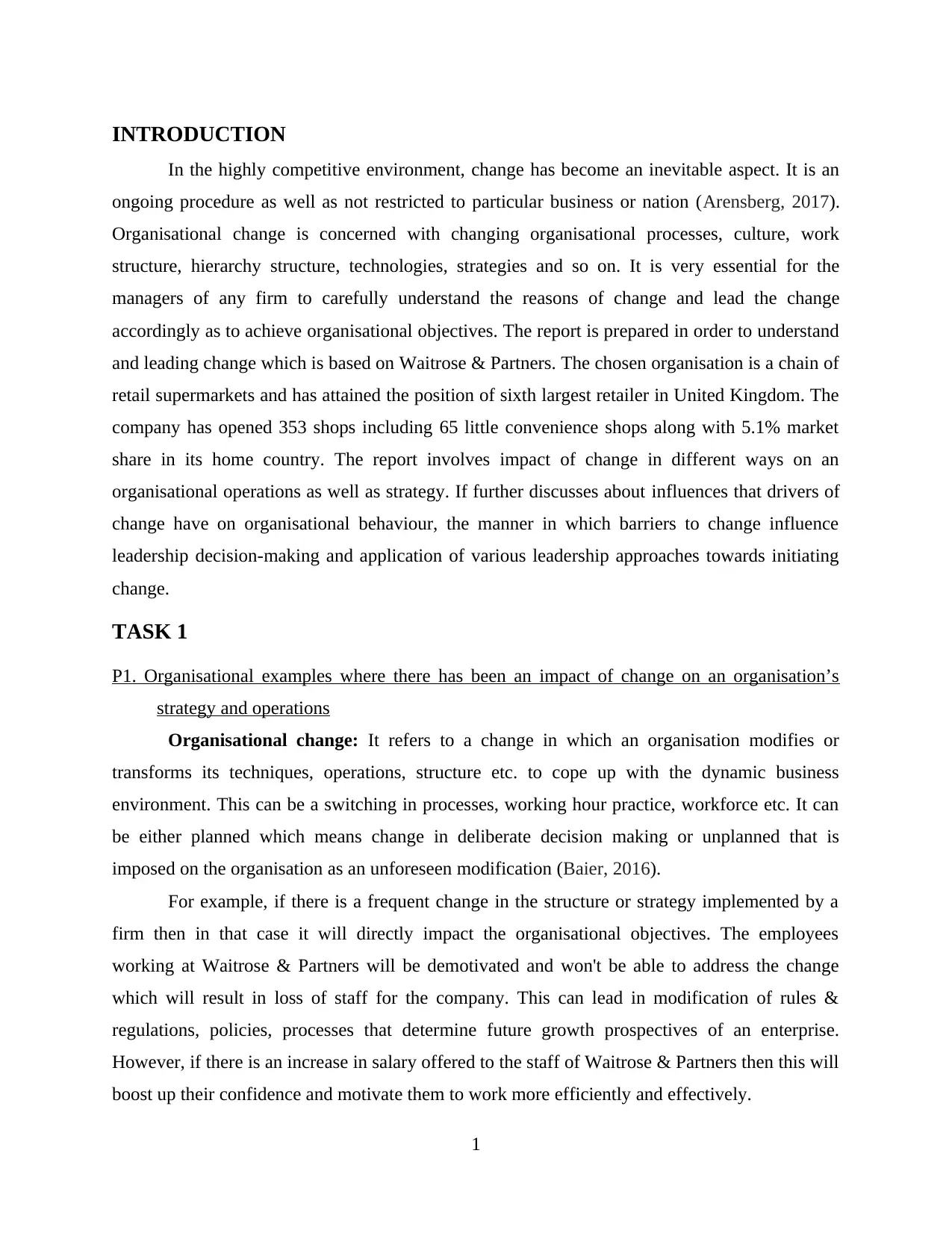
INTRODUCTION
In the highly competitive environment, change has become an inevitable aspect. It is an
ongoing procedure as well as not restricted to particular business or nation (Arensberg, 2017).
Organisational change is concerned with changing organisational processes, culture, work
structure, hierarchy structure, technologies, strategies and so on. It is very essential for the
managers of any firm to carefully understand the reasons of change and lead the change
accordingly as to achieve organisational objectives. The report is prepared in order to understand
and leading change which is based on Waitrose & Partners. The chosen organisation is a chain of
retail supermarkets and has attained the position of sixth largest retailer in United Kingdom. The
company has opened 353 shops including 65 little convenience shops along with 5.1% market
share in its home country. The report involves impact of change in different ways on an
organisational operations as well as strategy. If further discusses about influences that drivers of
change have on organisational behaviour, the manner in which barriers to change influence
leadership decision-making and application of various leadership approaches towards initiating
change.
TASK 1
P1. Organisational examples where there has been an impact of change on an organisation’s
strategy and operations
Organisational change: It refers to a change in which an organisation modifies or
transforms its techniques, operations, structure etc. to cope up with the dynamic business
environment. This can be a switching in processes, working hour practice, workforce etc. It can
be either planned which means change in deliberate decision making or unplanned that is
imposed on the organisation as an unforeseen modification (Baier, 2016).
For example, if there is a frequent change in the structure or strategy implemented by a
firm then in that case it will directly impact the organisational objectives. The employees
working at Waitrose & Partners will be demotivated and won't be able to address the change
which will result in loss of staff for the company. This can lead in modification of rules &
regulations, policies, processes that determine future growth prospectives of an enterprise.
However, if there is an increase in salary offered to the staff of Waitrose & Partners then this will
boost up their confidence and motivate them to work more efficiently and effectively.
1
In the highly competitive environment, change has become an inevitable aspect. It is an
ongoing procedure as well as not restricted to particular business or nation (Arensberg, 2017).
Organisational change is concerned with changing organisational processes, culture, work
structure, hierarchy structure, technologies, strategies and so on. It is very essential for the
managers of any firm to carefully understand the reasons of change and lead the change
accordingly as to achieve organisational objectives. The report is prepared in order to understand
and leading change which is based on Waitrose & Partners. The chosen organisation is a chain of
retail supermarkets and has attained the position of sixth largest retailer in United Kingdom. The
company has opened 353 shops including 65 little convenience shops along with 5.1% market
share in its home country. The report involves impact of change in different ways on an
organisational operations as well as strategy. If further discusses about influences that drivers of
change have on organisational behaviour, the manner in which barriers to change influence
leadership decision-making and application of various leadership approaches towards initiating
change.
TASK 1
P1. Organisational examples where there has been an impact of change on an organisation’s
strategy and operations
Organisational change: It refers to a change in which an organisation modifies or
transforms its techniques, operations, structure etc. to cope up with the dynamic business
environment. This can be a switching in processes, working hour practice, workforce etc. It can
be either planned which means change in deliberate decision making or unplanned that is
imposed on the organisation as an unforeseen modification (Baier, 2016).
For example, if there is a frequent change in the structure or strategy implemented by a
firm then in that case it will directly impact the organisational objectives. The employees
working at Waitrose & Partners will be demotivated and won't be able to address the change
which will result in loss of staff for the company. This can lead in modification of rules &
regulations, policies, processes that determine future growth prospectives of an enterprise.
However, if there is an increase in salary offered to the staff of Waitrose & Partners then this will
boost up their confidence and motivate them to work more efficiently and effectively.
1
⊘ This is a preview!⊘
Do you want full access?
Subscribe today to unlock all pages.

Trusted by 1+ million students worldwide
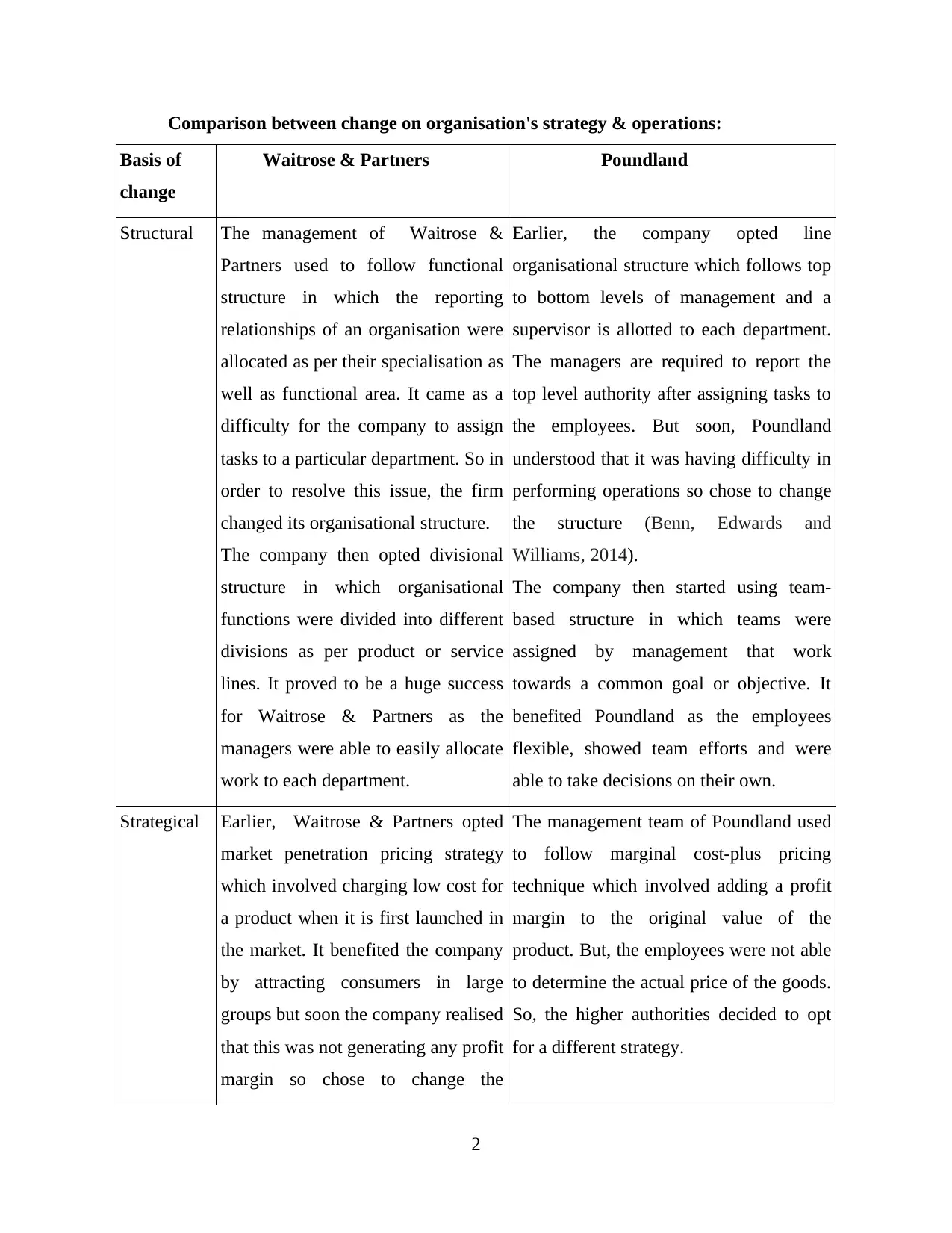
Comparison between change on organisation's strategy & operations:
Basis of
change
Waitrose & Partners Poundland
Structural The management of Waitrose &
Partners used to follow functional
structure in which the reporting
relationships of an organisation were
allocated as per their specialisation as
well as functional area. It came as a
difficulty for the company to assign
tasks to a particular department. So in
order to resolve this issue, the firm
changed its organisational structure.
The company then opted divisional
structure in which organisational
functions were divided into different
divisions as per product or service
lines. It proved to be a huge success
for Waitrose & Partners as the
managers were able to easily allocate
work to each department.
Earlier, the company opted line
organisational structure which follows top
to bottom levels of management and a
supervisor is allotted to each department.
The managers are required to report the
top level authority after assigning tasks to
the employees. But soon, Poundland
understood that it was having difficulty in
performing operations so chose to change
the structure (Benn, Edwards and
Williams, 2014).
The company then started using team-
based structure in which teams were
assigned by management that work
towards a common goal or objective. It
benefited Poundland as the employees
flexible, showed team efforts and were
able to take decisions on their own.
Strategical Earlier, Waitrose & Partners opted
market penetration pricing strategy
which involved charging low cost for
a product when it is first launched in
the market. It benefited the company
by attracting consumers in large
groups but soon the company realised
that this was not generating any profit
margin so chose to change the
The management team of Poundland used
to follow marginal cost-plus pricing
technique which involved adding a profit
margin to the original value of the
product. But, the employees were not able
to determine the actual price of the goods.
So, the higher authorities decided to opt
for a different strategy.
2
Basis of
change
Waitrose & Partners Poundland
Structural The management of Waitrose &
Partners used to follow functional
structure in which the reporting
relationships of an organisation were
allocated as per their specialisation as
well as functional area. It came as a
difficulty for the company to assign
tasks to a particular department. So in
order to resolve this issue, the firm
changed its organisational structure.
The company then opted divisional
structure in which organisational
functions were divided into different
divisions as per product or service
lines. It proved to be a huge success
for Waitrose & Partners as the
managers were able to easily allocate
work to each department.
Earlier, the company opted line
organisational structure which follows top
to bottom levels of management and a
supervisor is allotted to each department.
The managers are required to report the
top level authority after assigning tasks to
the employees. But soon, Poundland
understood that it was having difficulty in
performing operations so chose to change
the structure (Benn, Edwards and
Williams, 2014).
The company then started using team-
based structure in which teams were
assigned by management that work
towards a common goal or objective. It
benefited Poundland as the employees
flexible, showed team efforts and were
able to take decisions on their own.
Strategical Earlier, Waitrose & Partners opted
market penetration pricing strategy
which involved charging low cost for
a product when it is first launched in
the market. It benefited the company
by attracting consumers in large
groups but soon the company realised
that this was not generating any profit
margin so chose to change the
The management team of Poundland used
to follow marginal cost-plus pricing
technique which involved adding a profit
margin to the original value of the
product. But, the employees were not able
to determine the actual price of the goods.
So, the higher authorities decided to opt
for a different strategy.
2
Paraphrase This Document
Need a fresh take? Get an instant paraphrase of this document with our AI Paraphraser
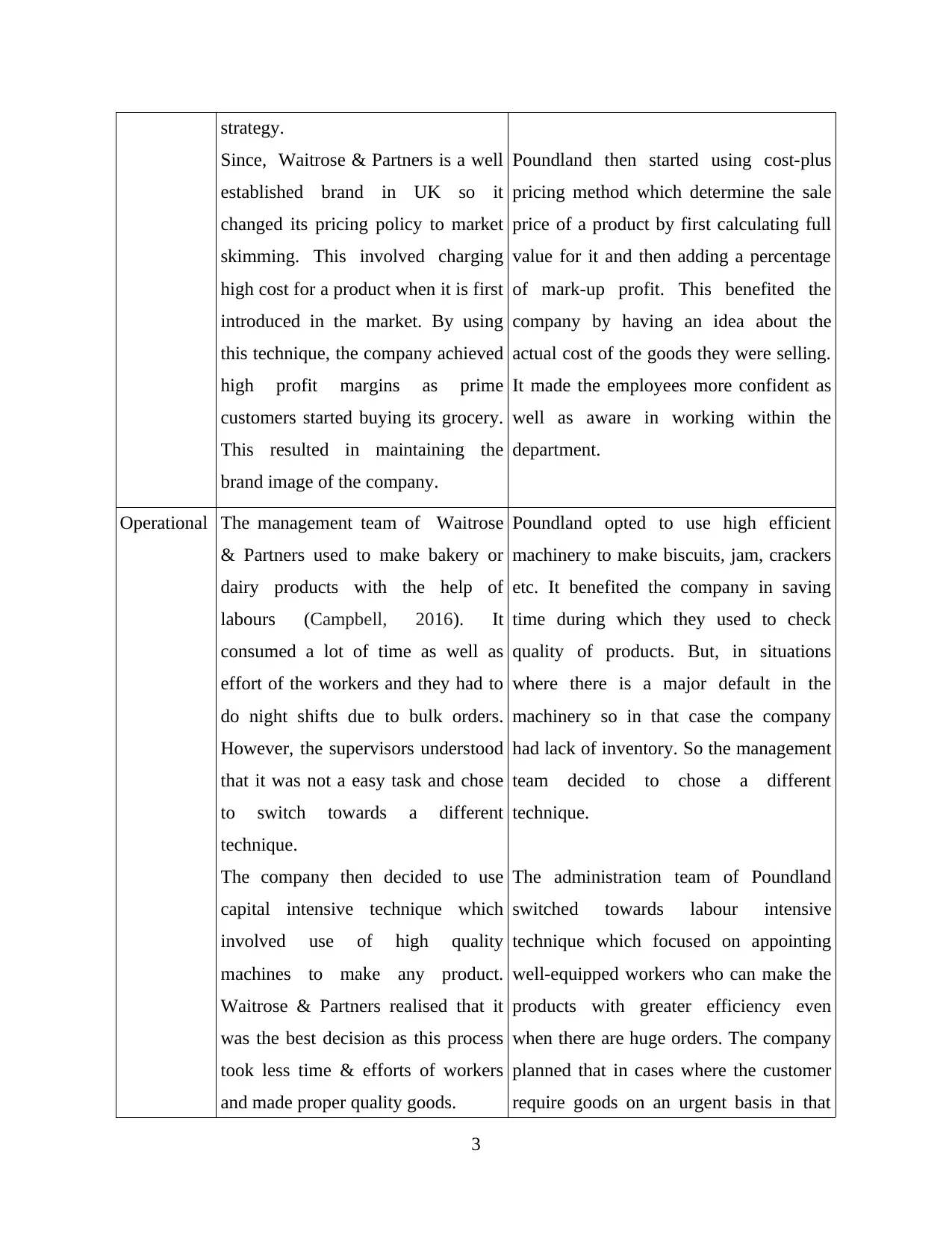
strategy.
Since, Waitrose & Partners is a well
established brand in UK so it
changed its pricing policy to market
skimming. This involved charging
high cost for a product when it is first
introduced in the market. By using
this technique, the company achieved
high profit margins as prime
customers started buying its grocery.
This resulted in maintaining the
brand image of the company.
Poundland then started using cost-plus
pricing method which determine the sale
price of a product by first calculating full
value for it and then adding a percentage
of mark-up profit. This benefited the
company by having an idea about the
actual cost of the goods they were selling.
It made the employees more confident as
well as aware in working within the
department.
Operational The management team of Waitrose
& Partners used to make bakery or
dairy products with the help of
labours (Campbell, 2016). It
consumed a lot of time as well as
effort of the workers and they had to
do night shifts due to bulk orders.
However, the supervisors understood
that it was not a easy task and chose
to switch towards a different
technique.
The company then decided to use
capital intensive technique which
involved use of high quality
machines to make any product.
Waitrose & Partners realised that it
was the best decision as this process
took less time & efforts of workers
and made proper quality goods.
Poundland opted to use high efficient
machinery to make biscuits, jam, crackers
etc. It benefited the company in saving
time during which they used to check
quality of products. But, in situations
where there is a major default in the
machinery so in that case the company
had lack of inventory. So the management
team decided to chose a different
technique.
The administration team of Poundland
switched towards labour intensive
technique which focused on appointing
well-equipped workers who can make the
products with greater efficiency even
when there are huge orders. The company
planned that in cases where the customer
require goods on an urgent basis in that
3
Since, Waitrose & Partners is a well
established brand in UK so it
changed its pricing policy to market
skimming. This involved charging
high cost for a product when it is first
introduced in the market. By using
this technique, the company achieved
high profit margins as prime
customers started buying its grocery.
This resulted in maintaining the
brand image of the company.
Poundland then started using cost-plus
pricing method which determine the sale
price of a product by first calculating full
value for it and then adding a percentage
of mark-up profit. This benefited the
company by having an idea about the
actual cost of the goods they were selling.
It made the employees more confident as
well as aware in working within the
department.
Operational The management team of Waitrose
& Partners used to make bakery or
dairy products with the help of
labours (Campbell, 2016). It
consumed a lot of time as well as
effort of the workers and they had to
do night shifts due to bulk orders.
However, the supervisors understood
that it was not a easy task and chose
to switch towards a different
technique.
The company then decided to use
capital intensive technique which
involved use of high quality
machines to make any product.
Waitrose & Partners realised that it
was the best decision as this process
took less time & efforts of workers
and made proper quality goods.
Poundland opted to use high efficient
machinery to make biscuits, jam, crackers
etc. It benefited the company in saving
time during which they used to check
quality of products. But, in situations
where there is a major default in the
machinery so in that case the company
had lack of inventory. So the management
team decided to chose a different
technique.
The administration team of Poundland
switched towards labour intensive
technique which focused on appointing
well-equipped workers who can make the
products with greater efficiency even
when there are huge orders. The company
planned that in cases where the customer
require goods on an urgent basis in that
3
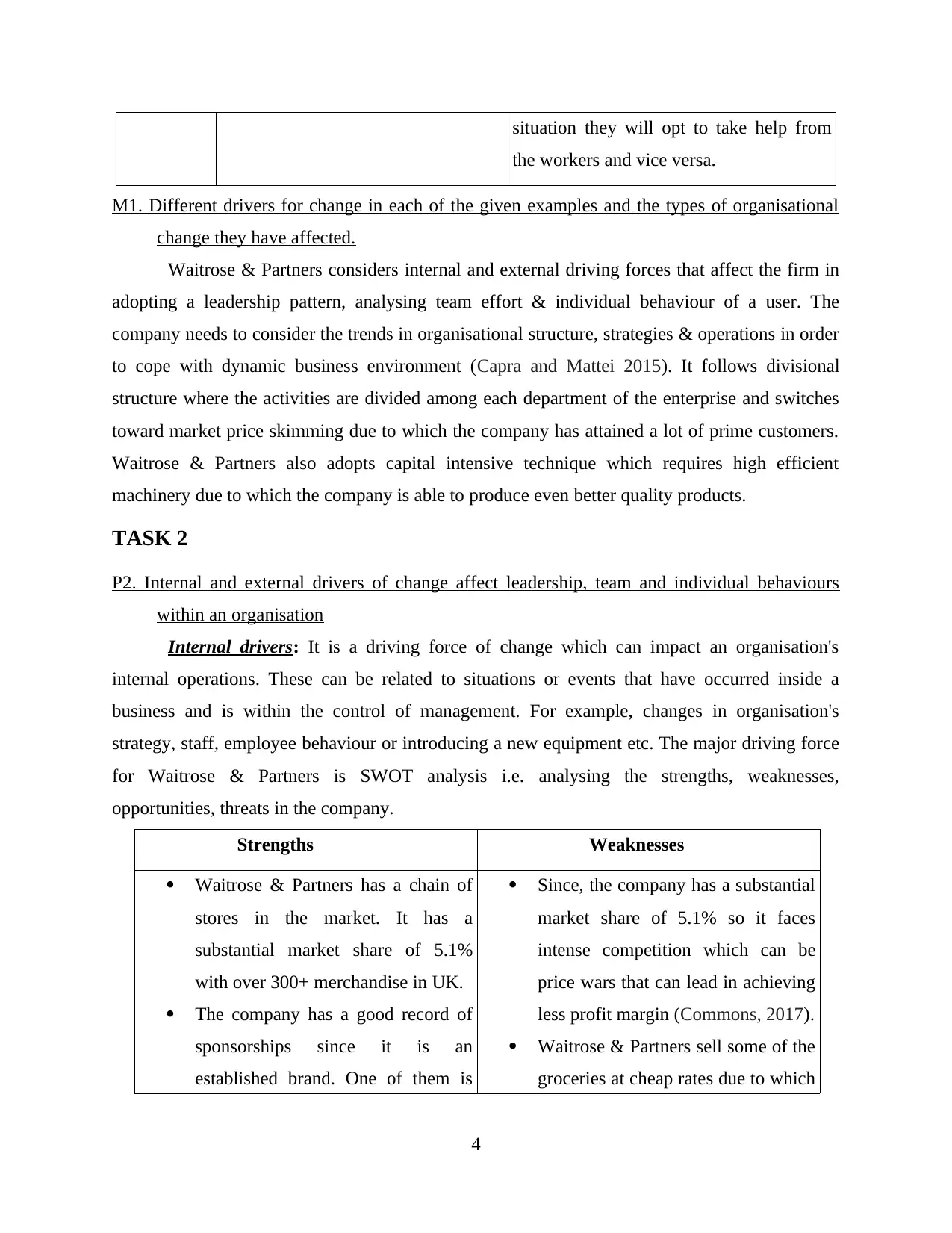
situation they will opt to take help from
the workers and vice versa.
M1. Different drivers for change in each of the given examples and the types of organisational
change they have affected.
Waitrose & Partners considers internal and external driving forces that affect the firm in
adopting a leadership pattern, analysing team effort & individual behaviour of a user. The
company needs to consider the trends in organisational structure, strategies & operations in order
to cope with dynamic business environment (Capra and Mattei 2015). It follows divisional
structure where the activities are divided among each department of the enterprise and switches
toward market price skimming due to which the company has attained a lot of prime customers.
Waitrose & Partners also adopts capital intensive technique which requires high efficient
machinery due to which the company is able to produce even better quality products.
TASK 2
P2. Internal and external drivers of change affect leadership, team and individual behaviours
within an organisation
Internal drivers: It is a driving force of change which can impact an organisation's
internal operations. These can be related to situations or events that have occurred inside a
business and is within the control of management. For example, changes in organisation's
strategy, staff, employee behaviour or introducing a new equipment etc. The major driving force
for Waitrose & Partners is SWOT analysis i.e. analysing the strengths, weaknesses,
opportunities, threats in the company.
Strengths Weaknesses
Waitrose & Partners has a chain of
stores in the market. It has a
substantial market share of 5.1%
with over 300+ merchandise in UK.
The company has a good record of
sponsorships since it is an
established brand. One of them is
Since, the company has a substantial
market share of 5.1% so it faces
intense competition which can be
price wars that can lead in achieving
less profit margin (Commons, 2017).
Waitrose & Partners sell some of the
groceries at cheap rates due to which
4
the workers and vice versa.
M1. Different drivers for change in each of the given examples and the types of organisational
change they have affected.
Waitrose & Partners considers internal and external driving forces that affect the firm in
adopting a leadership pattern, analysing team effort & individual behaviour of a user. The
company needs to consider the trends in organisational structure, strategies & operations in order
to cope with dynamic business environment (Capra and Mattei 2015). It follows divisional
structure where the activities are divided among each department of the enterprise and switches
toward market price skimming due to which the company has attained a lot of prime customers.
Waitrose & Partners also adopts capital intensive technique which requires high efficient
machinery due to which the company is able to produce even better quality products.
TASK 2
P2. Internal and external drivers of change affect leadership, team and individual behaviours
within an organisation
Internal drivers: It is a driving force of change which can impact an organisation's
internal operations. These can be related to situations or events that have occurred inside a
business and is within the control of management. For example, changes in organisation's
strategy, staff, employee behaviour or introducing a new equipment etc. The major driving force
for Waitrose & Partners is SWOT analysis i.e. analysing the strengths, weaknesses,
opportunities, threats in the company.
Strengths Weaknesses
Waitrose & Partners has a chain of
stores in the market. It has a
substantial market share of 5.1%
with over 300+ merchandise in UK.
The company has a good record of
sponsorships since it is an
established brand. One of them is
Since, the company has a substantial
market share of 5.1% so it faces
intense competition which can be
price wars that can lead in achieving
less profit margin (Commons, 2017).
Waitrose & Partners sell some of the
groceries at cheap rates due to which
4
⊘ This is a preview!⊘
Do you want full access?
Subscribe today to unlock all pages.

Trusted by 1+ million students worldwide
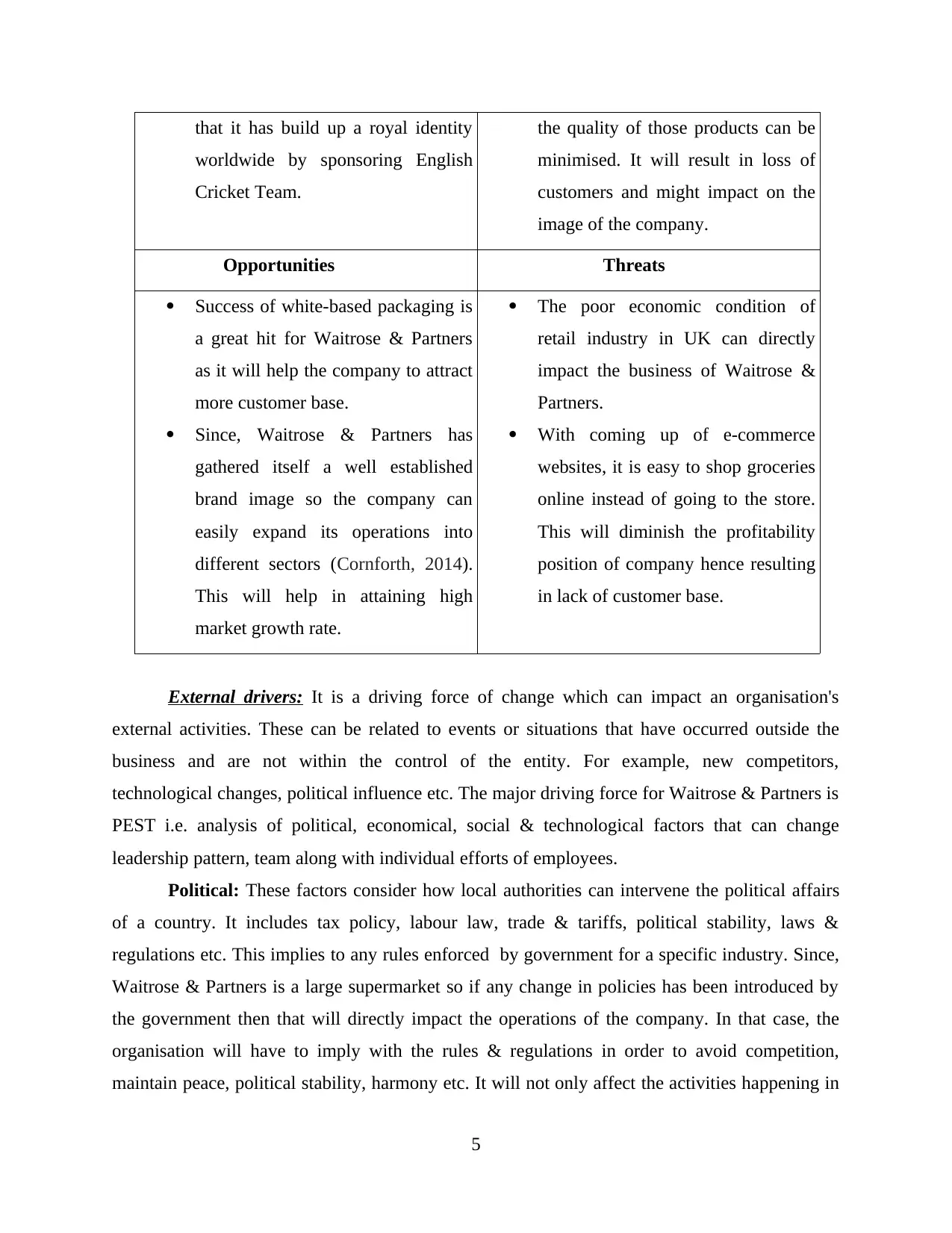
that it has build up a royal identity
worldwide by sponsoring English
Cricket Team.
the quality of those products can be
minimised. It will result in loss of
customers and might impact on the
image of the company.
Opportunities Threats
Success of white-based packaging is
a great hit for Waitrose & Partners
as it will help the company to attract
more customer base.
Since, Waitrose & Partners has
gathered itself a well established
brand image so the company can
easily expand its operations into
different sectors (Cornforth, 2014).
This will help in attaining high
market growth rate.
The poor economic condition of
retail industry in UK can directly
impact the business of Waitrose &
Partners.
With coming up of e-commerce
websites, it is easy to shop groceries
online instead of going to the store.
This will diminish the profitability
position of company hence resulting
in lack of customer base.
External drivers: It is a driving force of change which can impact an organisation's
external activities. These can be related to events or situations that have occurred outside the
business and are not within the control of the entity. For example, new competitors,
technological changes, political influence etc. The major driving force for Waitrose & Partners is
PEST i.e. analysis of political, economical, social & technological factors that can change
leadership pattern, team along with individual efforts of employees.
Political: These factors consider how local authorities can intervene the political affairs
of a country. It includes tax policy, labour law, trade & tariffs, political stability, laws &
regulations etc. This implies to any rules enforced by government for a specific industry. Since,
Waitrose & Partners is a large supermarket so if any change in policies has been introduced by
the government then that will directly impact the operations of the company. In that case, the
organisation will have to imply with the rules & regulations in order to avoid competition,
maintain peace, political stability, harmony etc. It will not only affect the activities happening in
5
worldwide by sponsoring English
Cricket Team.
the quality of those products can be
minimised. It will result in loss of
customers and might impact on the
image of the company.
Opportunities Threats
Success of white-based packaging is
a great hit for Waitrose & Partners
as it will help the company to attract
more customer base.
Since, Waitrose & Partners has
gathered itself a well established
brand image so the company can
easily expand its operations into
different sectors (Cornforth, 2014).
This will help in attaining high
market growth rate.
The poor economic condition of
retail industry in UK can directly
impact the business of Waitrose &
Partners.
With coming up of e-commerce
websites, it is easy to shop groceries
online instead of going to the store.
This will diminish the profitability
position of company hence resulting
in lack of customer base.
External drivers: It is a driving force of change which can impact an organisation's
external activities. These can be related to events or situations that have occurred outside the
business and are not within the control of the entity. For example, new competitors,
technological changes, political influence etc. The major driving force for Waitrose & Partners is
PEST i.e. analysis of political, economical, social & technological factors that can change
leadership pattern, team along with individual efforts of employees.
Political: These factors consider how local authorities can intervene the political affairs
of a country. It includes tax policy, labour law, trade & tariffs, political stability, laws &
regulations etc. This implies to any rules enforced by government for a specific industry. Since,
Waitrose & Partners is a large supermarket so if any change in policies has been introduced by
the government then that will directly impact the operations of the company. In that case, the
organisation will have to imply with the rules & regulations in order to avoid competition,
maintain peace, political stability, harmony etc. It will not only affect the activities happening in
5
Paraphrase This Document
Need a fresh take? Get an instant paraphrase of this document with our AI Paraphraser
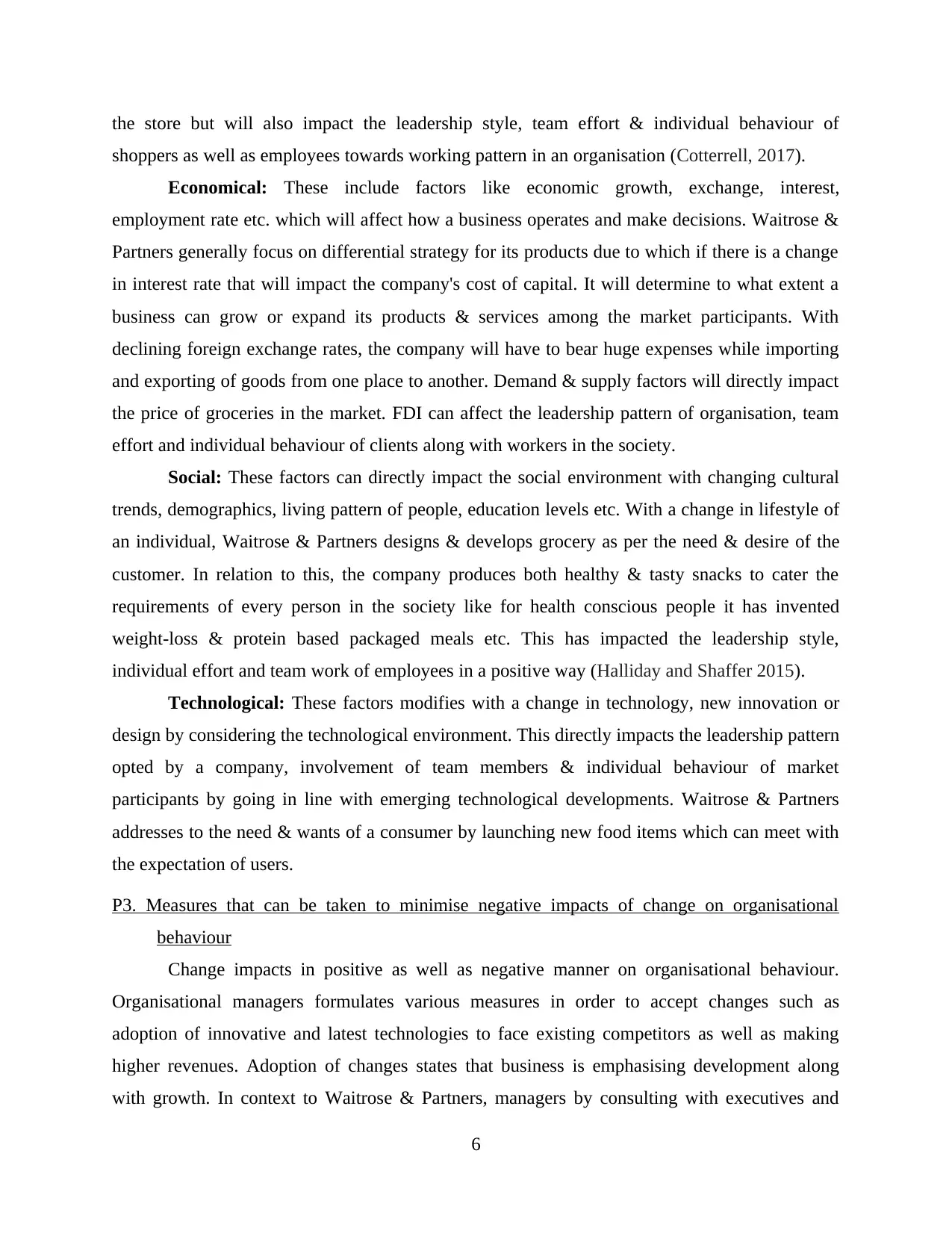
the store but will also impact the leadership style, team effort & individual behaviour of
shoppers as well as employees towards working pattern in an organisation (Cotterrell, 2017).
Economical: These include factors like economic growth, exchange, interest,
employment rate etc. which will affect how a business operates and make decisions. Waitrose &
Partners generally focus on differential strategy for its products due to which if there is a change
in interest rate that will impact the company's cost of capital. It will determine to what extent a
business can grow or expand its products & services among the market participants. With
declining foreign exchange rates, the company will have to bear huge expenses while importing
and exporting of goods from one place to another. Demand & supply factors will directly impact
the price of groceries in the market. FDI can affect the leadership pattern of organisation, team
effort and individual behaviour of clients along with workers in the society.
Social: These factors can directly impact the social environment with changing cultural
trends, demographics, living pattern of people, education levels etc. With a change in lifestyle of
an individual, Waitrose & Partners designs & develops grocery as per the need & desire of the
customer. In relation to this, the company produces both healthy & tasty snacks to cater the
requirements of every person in the society like for health conscious people it has invented
weight-loss & protein based packaged meals etc. This has impacted the leadership style,
individual effort and team work of employees in a positive way (Halliday and Shaffer 2015).
Technological: These factors modifies with a change in technology, new innovation or
design by considering the technological environment. This directly impacts the leadership pattern
opted by a company, involvement of team members & individual behaviour of market
participants by going in line with emerging technological developments. Waitrose & Partners
addresses to the need & wants of a consumer by launching new food items which can meet with
the expectation of users.
P3. Measures that can be taken to minimise negative impacts of change on organisational
behaviour
Change impacts in positive as well as negative manner on organisational behaviour.
Organisational managers formulates various measures in order to accept changes such as
adoption of innovative and latest technologies to face existing competitors as well as making
higher revenues. Adoption of changes states that business is emphasising development along
with growth. In context to Waitrose & Partners, managers by consulting with executives and
6
shoppers as well as employees towards working pattern in an organisation (Cotterrell, 2017).
Economical: These include factors like economic growth, exchange, interest,
employment rate etc. which will affect how a business operates and make decisions. Waitrose &
Partners generally focus on differential strategy for its products due to which if there is a change
in interest rate that will impact the company's cost of capital. It will determine to what extent a
business can grow or expand its products & services among the market participants. With
declining foreign exchange rates, the company will have to bear huge expenses while importing
and exporting of goods from one place to another. Demand & supply factors will directly impact
the price of groceries in the market. FDI can affect the leadership pattern of organisation, team
effort and individual behaviour of clients along with workers in the society.
Social: These factors can directly impact the social environment with changing cultural
trends, demographics, living pattern of people, education levels etc. With a change in lifestyle of
an individual, Waitrose & Partners designs & develops grocery as per the need & desire of the
customer. In relation to this, the company produces both healthy & tasty snacks to cater the
requirements of every person in the society like for health conscious people it has invented
weight-loss & protein based packaged meals etc. This has impacted the leadership style,
individual effort and team work of employees in a positive way (Halliday and Shaffer 2015).
Technological: These factors modifies with a change in technology, new innovation or
design by considering the technological environment. This directly impacts the leadership pattern
opted by a company, involvement of team members & individual behaviour of market
participants by going in line with emerging technological developments. Waitrose & Partners
addresses to the need & wants of a consumer by launching new food items which can meet with
the expectation of users.
P3. Measures that can be taken to minimise negative impacts of change on organisational
behaviour
Change impacts in positive as well as negative manner on organisational behaviour.
Organisational managers formulates various measures in order to accept changes such as
adoption of innovative and latest technologies to face existing competitors as well as making
higher revenues. Adoption of changes states that business is emphasising development along
with growth. In context to Waitrose & Partners, managers by consulting with executives and
6
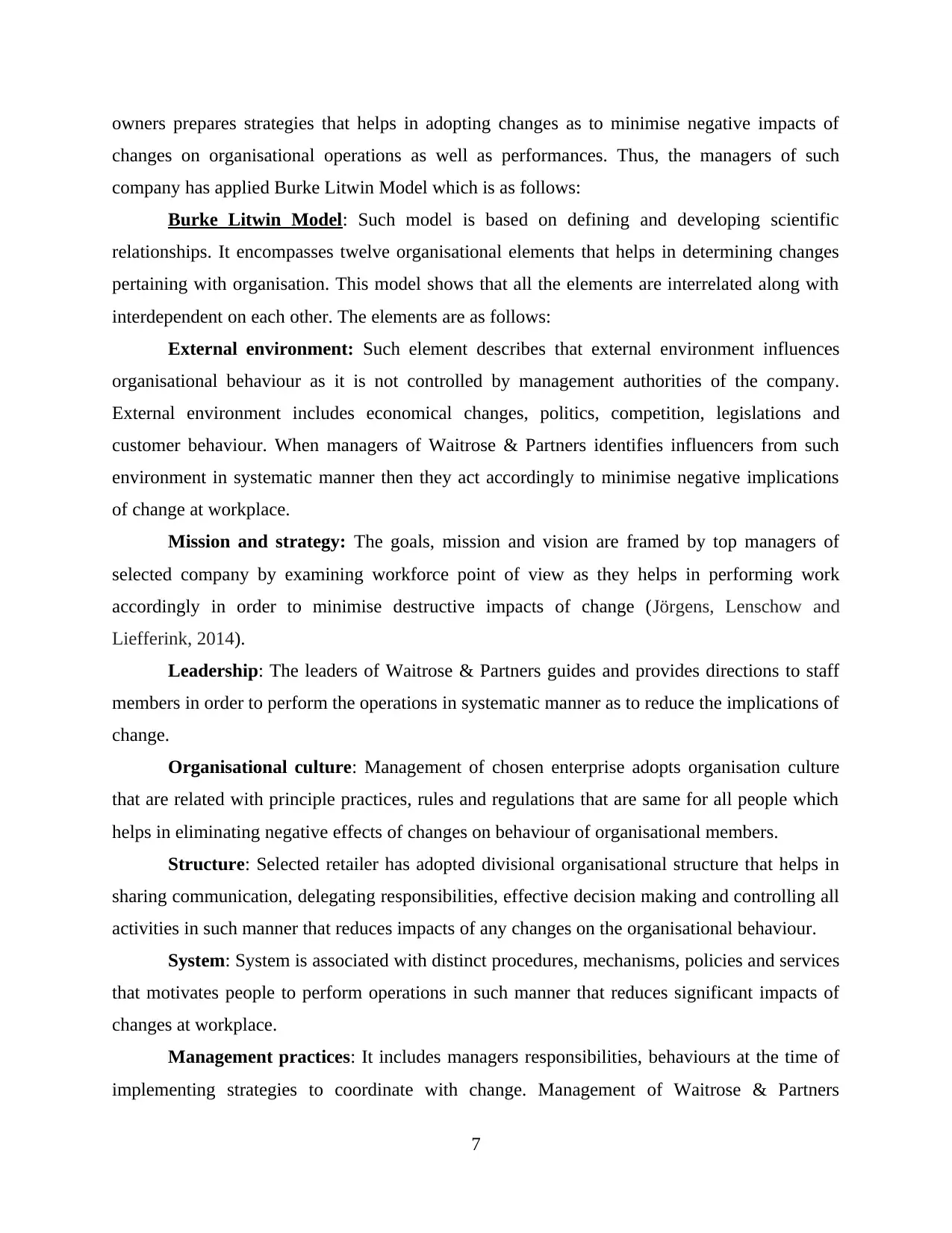
owners prepares strategies that helps in adopting changes as to minimise negative impacts of
changes on organisational operations as well as performances. Thus, the managers of such
company has applied Burke Litwin Model which is as follows:
Burke Litwin Model: Such model is based on defining and developing scientific
relationships. It encompasses twelve organisational elements that helps in determining changes
pertaining with organisation. This model shows that all the elements are interrelated along with
interdependent on each other. The elements are as follows:
External environment: Such element describes that external environment influences
organisational behaviour as it is not controlled by management authorities of the company.
External environment includes economical changes, politics, competition, legislations and
customer behaviour. When managers of Waitrose & Partners identifies influencers from such
environment in systematic manner then they act accordingly to minimise negative implications
of change at workplace.
Mission and strategy: The goals, mission and vision are framed by top managers of
selected company by examining workforce point of view as they helps in performing work
accordingly in order to minimise destructive impacts of change (Jörgens, Lenschow and
Liefferink, 2014).
Leadership: The leaders of Waitrose & Partners guides and provides directions to staff
members in order to perform the operations in systematic manner as to reduce the implications of
change.
Organisational culture: Management of chosen enterprise adopts organisation culture
that are related with principle practices, rules and regulations that are same for all people which
helps in eliminating negative effects of changes on behaviour of organisational members.
Structure: Selected retailer has adopted divisional organisational structure that helps in
sharing communication, delegating responsibilities, effective decision making and controlling all
activities in such manner that reduces impacts of any changes on the organisational behaviour.
System: System is associated with distinct procedures, mechanisms, policies and services
that motivates people to perform operations in such manner that reduces significant impacts of
changes at workplace.
Management practices: It includes managers responsibilities, behaviours at the time of
implementing strategies to coordinate with change. Management of Waitrose & Partners
7
changes on organisational operations as well as performances. Thus, the managers of such
company has applied Burke Litwin Model which is as follows:
Burke Litwin Model: Such model is based on defining and developing scientific
relationships. It encompasses twelve organisational elements that helps in determining changes
pertaining with organisation. This model shows that all the elements are interrelated along with
interdependent on each other. The elements are as follows:
External environment: Such element describes that external environment influences
organisational behaviour as it is not controlled by management authorities of the company.
External environment includes economical changes, politics, competition, legislations and
customer behaviour. When managers of Waitrose & Partners identifies influencers from such
environment in systematic manner then they act accordingly to minimise negative implications
of change at workplace.
Mission and strategy: The goals, mission and vision are framed by top managers of
selected company by examining workforce point of view as they helps in performing work
accordingly in order to minimise destructive impacts of change (Jörgens, Lenschow and
Liefferink, 2014).
Leadership: The leaders of Waitrose & Partners guides and provides directions to staff
members in order to perform the operations in systematic manner as to reduce the implications of
change.
Organisational culture: Management of chosen enterprise adopts organisation culture
that are related with principle practices, rules and regulations that are same for all people which
helps in eliminating negative effects of changes on behaviour of organisational members.
Structure: Selected retailer has adopted divisional organisational structure that helps in
sharing communication, delegating responsibilities, effective decision making and controlling all
activities in such manner that reduces impacts of any changes on the organisational behaviour.
System: System is associated with distinct procedures, mechanisms, policies and services
that motivates people to perform operations in such manner that reduces significant impacts of
changes at workplace.
Management practices: It includes managers responsibilities, behaviours at the time of
implementing strategies to coordinate with change. Management of Waitrose & Partners
7
⊘ This is a preview!⊘
Do you want full access?
Subscribe today to unlock all pages.

Trusted by 1+ million students worldwide
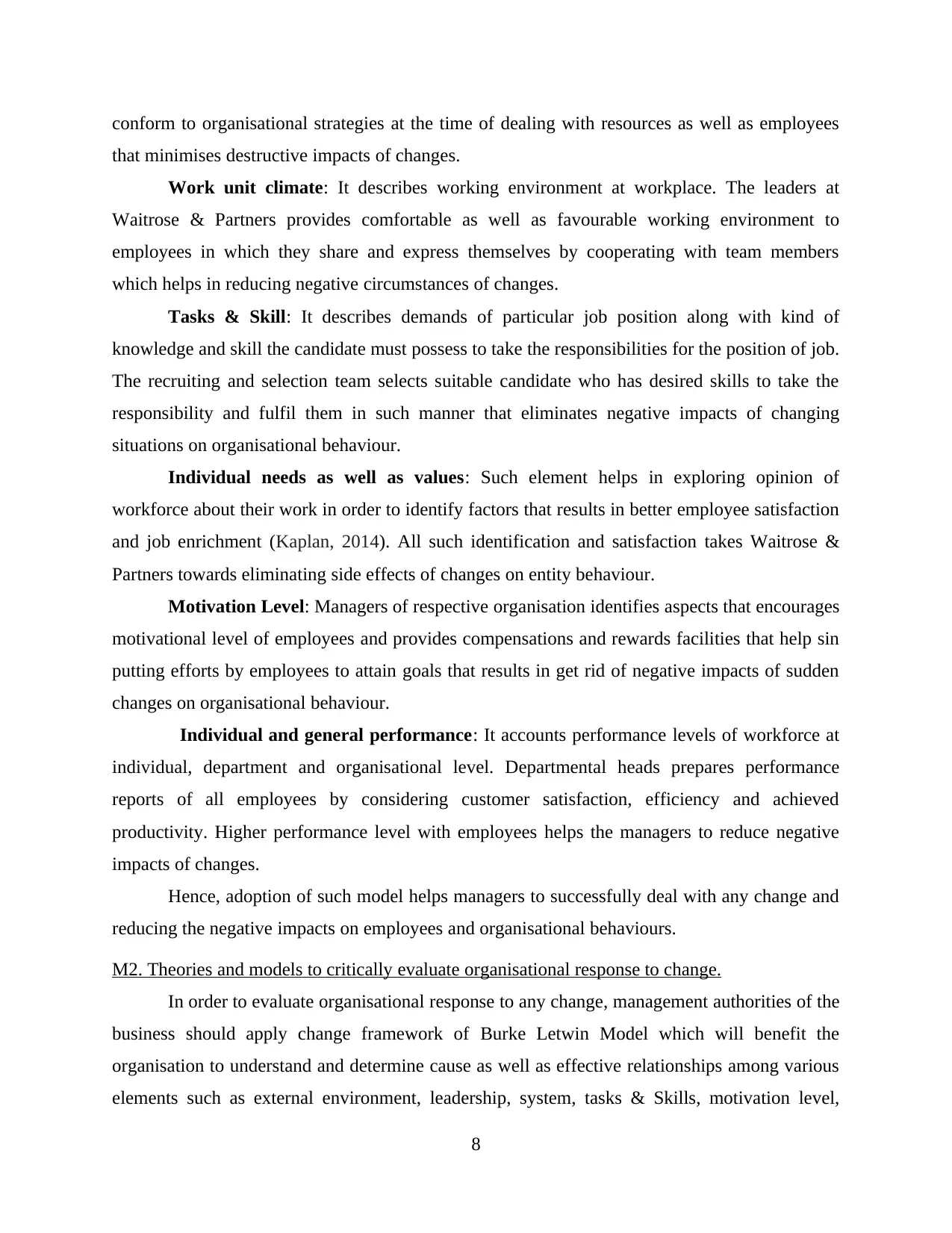
conform to organisational strategies at the time of dealing with resources as well as employees
that minimises destructive impacts of changes.
Work unit climate: It describes working environment at workplace. The leaders at
Waitrose & Partners provides comfortable as well as favourable working environment to
employees in which they share and express themselves by cooperating with team members
which helps in reducing negative circumstances of changes.
Tasks & Skill: It describes demands of particular job position along with kind of
knowledge and skill the candidate must possess to take the responsibilities for the position of job.
The recruiting and selection team selects suitable candidate who has desired skills to take the
responsibility and fulfil them in such manner that eliminates negative impacts of changing
situations on organisational behaviour.
Individual needs as well as values: Such element helps in exploring opinion of
workforce about their work in order to identify factors that results in better employee satisfaction
and job enrichment (Kaplan, 2014). All such identification and satisfaction takes Waitrose &
Partners towards eliminating side effects of changes on entity behaviour.
Motivation Level: Managers of respective organisation identifies aspects that encourages
motivational level of employees and provides compensations and rewards facilities that help sin
putting efforts by employees to attain goals that results in get rid of negative impacts of sudden
changes on organisational behaviour.
Individual and general performance: It accounts performance levels of workforce at
individual, department and organisational level. Departmental heads prepares performance
reports of all employees by considering customer satisfaction, efficiency and achieved
productivity. Higher performance level with employees helps the managers to reduce negative
impacts of changes.
Hence, adoption of such model helps managers to successfully deal with any change and
reducing the negative impacts on employees and organisational behaviours.
M2. Theories and models to critically evaluate organisational response to change.
In order to evaluate organisational response to any change, management authorities of the
business should apply change framework of Burke Letwin Model which will benefit the
organisation to understand and determine cause as well as effective relationships among various
elements such as external environment, leadership, system, tasks & Skills, motivation level,
8
that minimises destructive impacts of changes.
Work unit climate: It describes working environment at workplace. The leaders at
Waitrose & Partners provides comfortable as well as favourable working environment to
employees in which they share and express themselves by cooperating with team members
which helps in reducing negative circumstances of changes.
Tasks & Skill: It describes demands of particular job position along with kind of
knowledge and skill the candidate must possess to take the responsibilities for the position of job.
The recruiting and selection team selects suitable candidate who has desired skills to take the
responsibility and fulfil them in such manner that eliminates negative impacts of changing
situations on organisational behaviour.
Individual needs as well as values: Such element helps in exploring opinion of
workforce about their work in order to identify factors that results in better employee satisfaction
and job enrichment (Kaplan, 2014). All such identification and satisfaction takes Waitrose &
Partners towards eliminating side effects of changes on entity behaviour.
Motivation Level: Managers of respective organisation identifies aspects that encourages
motivational level of employees and provides compensations and rewards facilities that help sin
putting efforts by employees to attain goals that results in get rid of negative impacts of sudden
changes on organisational behaviour.
Individual and general performance: It accounts performance levels of workforce at
individual, department and organisational level. Departmental heads prepares performance
reports of all employees by considering customer satisfaction, efficiency and achieved
productivity. Higher performance level with employees helps the managers to reduce negative
impacts of changes.
Hence, adoption of such model helps managers to successfully deal with any change and
reducing the negative impacts on employees and organisational behaviours.
M2. Theories and models to critically evaluate organisational response to change.
In order to evaluate organisational response to any change, management authorities of the
business should apply change framework of Burke Letwin Model which will benefit the
organisation to understand and determine cause as well as effective relationships among various
elements such as external environment, leadership, system, tasks & Skills, motivation level,
8
Paraphrase This Document
Need a fresh take? Get an instant paraphrase of this document with our AI Paraphraser
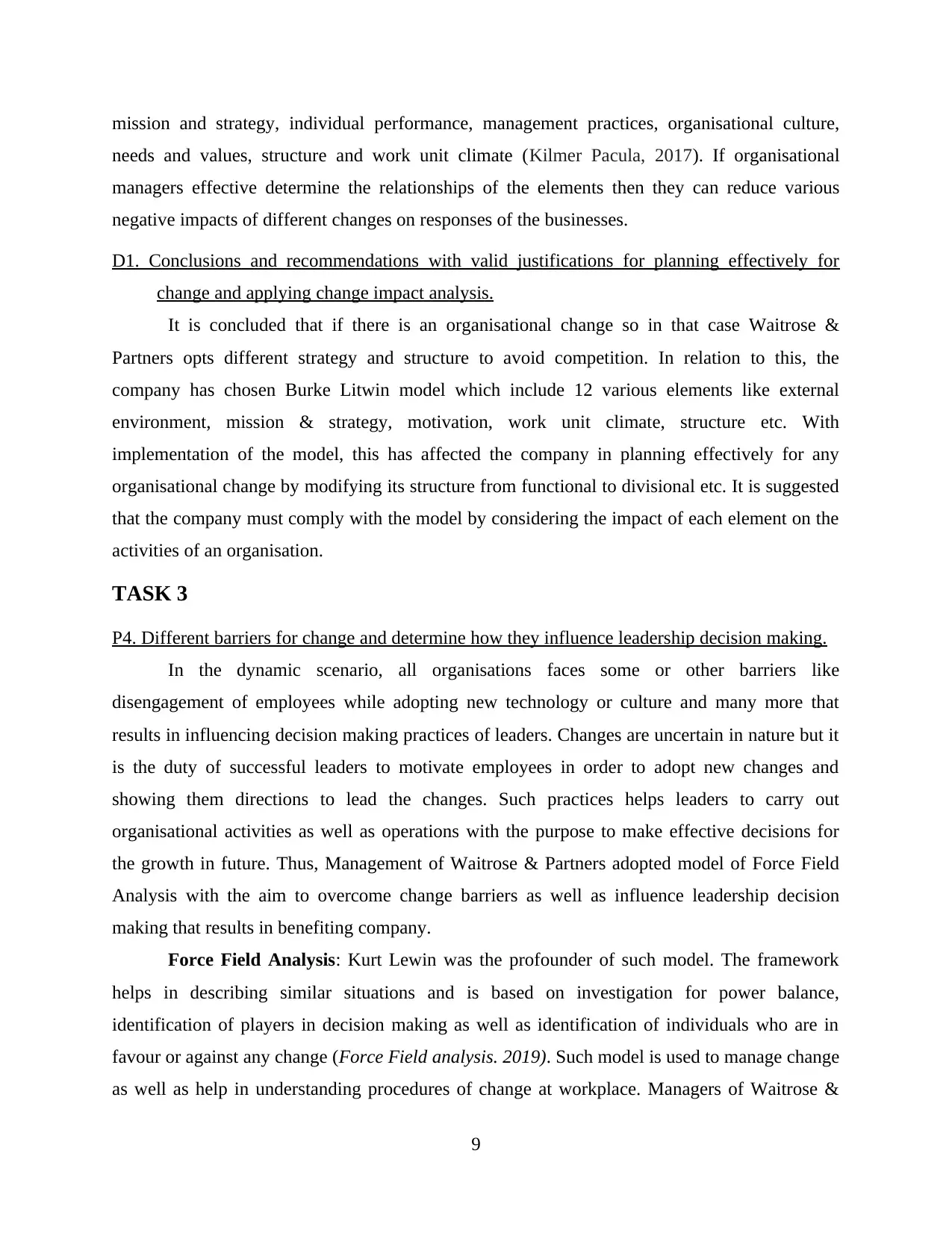
mission and strategy, individual performance, management practices, organisational culture,
needs and values, structure and work unit climate (Kilmer Pacula, 2017). If organisational
managers effective determine the relationships of the elements then they can reduce various
negative impacts of different changes on responses of the businesses.
D1. Conclusions and recommendations with valid justifications for planning effectively for
change and applying change impact analysis.
It is concluded that if there is an organisational change so in that case Waitrose &
Partners opts different strategy and structure to avoid competition. In relation to this, the
company has chosen Burke Litwin model which include 12 various elements like external
environment, mission & strategy, motivation, work unit climate, structure etc. With
implementation of the model, this has affected the company in planning effectively for any
organisational change by modifying its structure from functional to divisional etc. It is suggested
that the company must comply with the model by considering the impact of each element on the
activities of an organisation.
TASK 3
P4. Different barriers for change and determine how they influence leadership decision making.
In the dynamic scenario, all organisations faces some or other barriers like
disengagement of employees while adopting new technology or culture and many more that
results in influencing decision making practices of leaders. Changes are uncertain in nature but it
is the duty of successful leaders to motivate employees in order to adopt new changes and
showing them directions to lead the changes. Such practices helps leaders to carry out
organisational activities as well as operations with the purpose to make effective decisions for
the growth in future. Thus, Management of Waitrose & Partners adopted model of Force Field
Analysis with the aim to overcome change barriers as well as influence leadership decision
making that results in benefiting company.
Force Field Analysis: Kurt Lewin was the profounder of such model. The framework
helps in describing similar situations and is based on investigation for power balance,
identification of players in decision making as well as identification of individuals who are in
favour or against any change (Force Field analysis. 2019). Such model is used to manage change
as well as help in understanding procedures of change at workplace. Managers of Waitrose &
9
needs and values, structure and work unit climate (Kilmer Pacula, 2017). If organisational
managers effective determine the relationships of the elements then they can reduce various
negative impacts of different changes on responses of the businesses.
D1. Conclusions and recommendations with valid justifications for planning effectively for
change and applying change impact analysis.
It is concluded that if there is an organisational change so in that case Waitrose &
Partners opts different strategy and structure to avoid competition. In relation to this, the
company has chosen Burke Litwin model which include 12 various elements like external
environment, mission & strategy, motivation, work unit climate, structure etc. With
implementation of the model, this has affected the company in planning effectively for any
organisational change by modifying its structure from functional to divisional etc. It is suggested
that the company must comply with the model by considering the impact of each element on the
activities of an organisation.
TASK 3
P4. Different barriers for change and determine how they influence leadership decision making.
In the dynamic scenario, all organisations faces some or other barriers like
disengagement of employees while adopting new technology or culture and many more that
results in influencing decision making practices of leaders. Changes are uncertain in nature but it
is the duty of successful leaders to motivate employees in order to adopt new changes and
showing them directions to lead the changes. Such practices helps leaders to carry out
organisational activities as well as operations with the purpose to make effective decisions for
the growth in future. Thus, Management of Waitrose & Partners adopted model of Force Field
Analysis with the aim to overcome change barriers as well as influence leadership decision
making that results in benefiting company.
Force Field Analysis: Kurt Lewin was the profounder of such model. The framework
helps in describing similar situations and is based on investigation for power balance,
identification of players in decision making as well as identification of individuals who are in
favour or against any change (Force Field analysis. 2019). Such model is used to manage change
as well as help in understanding procedures of change at workplace. Managers of Waitrose &
9
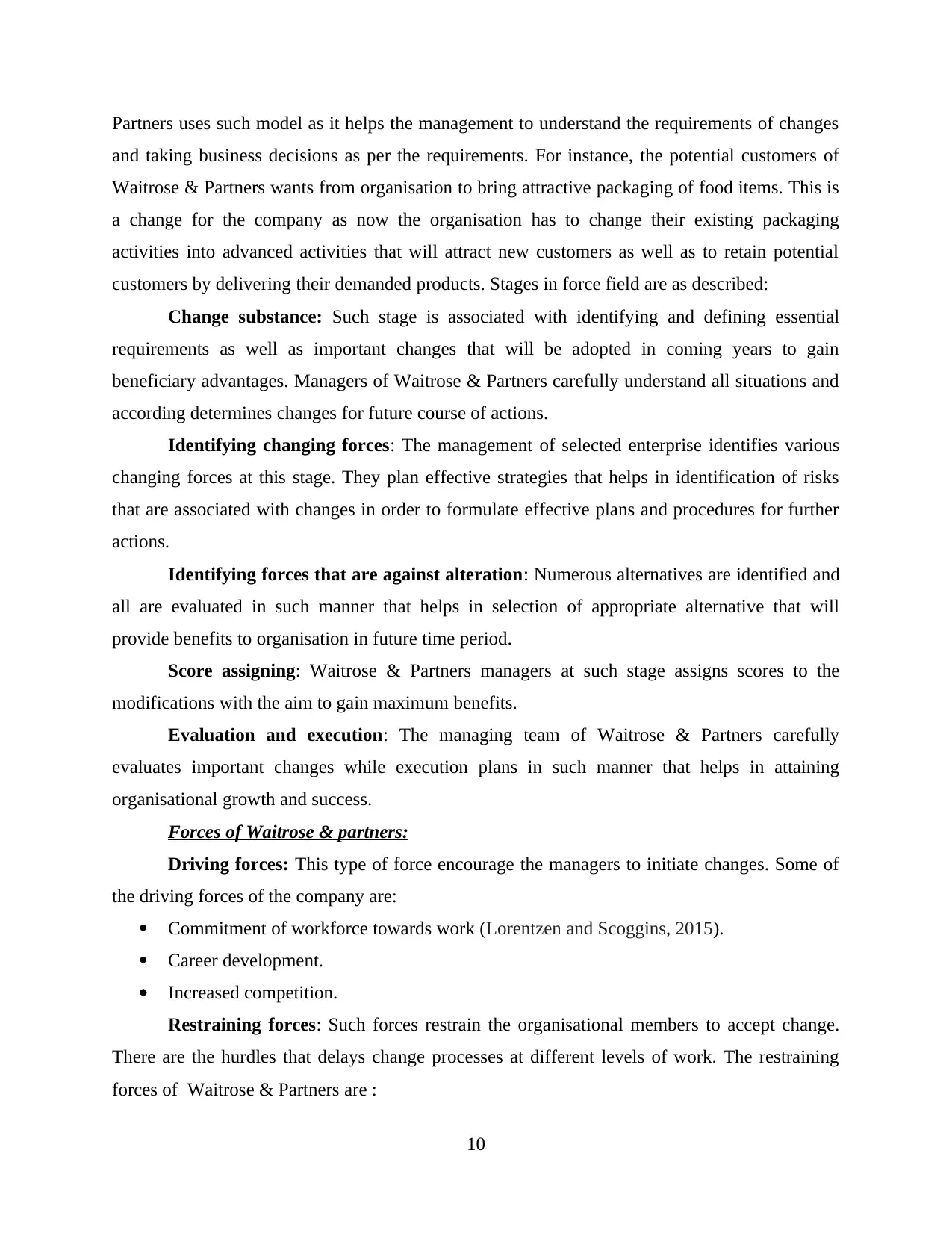
Partners uses such model as it helps the management to understand the requirements of changes
and taking business decisions as per the requirements. For instance, the potential customers of
Waitrose & Partners wants from organisation to bring attractive packaging of food items. This is
a change for the company as now the organisation has to change their existing packaging
activities into advanced activities that will attract new customers as well as to retain potential
customers by delivering their demanded products. Stages in force field are as described:
Change substance: Such stage is associated with identifying and defining essential
requirements as well as important changes that will be adopted in coming years to gain
beneficiary advantages. Managers of Waitrose & Partners carefully understand all situations and
according determines changes for future course of actions.
Identifying changing forces: The management of selected enterprise identifies various
changing forces at this stage. They plan effective strategies that helps in identification of risks
that are associated with changes in order to formulate effective plans and procedures for further
actions.
Identifying forces that are against alteration: Numerous alternatives are identified and
all are evaluated in such manner that helps in selection of appropriate alternative that will
provide benefits to organisation in future time period.
Score assigning: Waitrose & Partners managers at such stage assigns scores to the
modifications with the aim to gain maximum benefits.
Evaluation and execution: The managing team of Waitrose & Partners carefully
evaluates important changes while execution plans in such manner that helps in attaining
organisational growth and success.
Forces of Waitrose & partners:
Driving forces: This type of force encourage the managers to initiate changes. Some of
the driving forces of the company are:
Commitment of workforce towards work (Lorentzen and Scoggins, 2015).
Career development.
Increased competition.
Restraining forces: Such forces restrain the organisational members to accept change.
There are the hurdles that delays change processes at different levels of work. The restraining
forces of Waitrose & Partners are :
10
and taking business decisions as per the requirements. For instance, the potential customers of
Waitrose & Partners wants from organisation to bring attractive packaging of food items. This is
a change for the company as now the organisation has to change their existing packaging
activities into advanced activities that will attract new customers as well as to retain potential
customers by delivering their demanded products. Stages in force field are as described:
Change substance: Such stage is associated with identifying and defining essential
requirements as well as important changes that will be adopted in coming years to gain
beneficiary advantages. Managers of Waitrose & Partners carefully understand all situations and
according determines changes for future course of actions.
Identifying changing forces: The management of selected enterprise identifies various
changing forces at this stage. They plan effective strategies that helps in identification of risks
that are associated with changes in order to formulate effective plans and procedures for further
actions.
Identifying forces that are against alteration: Numerous alternatives are identified and
all are evaluated in such manner that helps in selection of appropriate alternative that will
provide benefits to organisation in future time period.
Score assigning: Waitrose & Partners managers at such stage assigns scores to the
modifications with the aim to gain maximum benefits.
Evaluation and execution: The managing team of Waitrose & Partners carefully
evaluates important changes while execution plans in such manner that helps in attaining
organisational growth and success.
Forces of Waitrose & partners:
Driving forces: This type of force encourage the managers to initiate changes. Some of
the driving forces of the company are:
Commitment of workforce towards work (Lorentzen and Scoggins, 2015).
Career development.
Increased competition.
Restraining forces: Such forces restrain the organisational members to accept change.
There are the hurdles that delays change processes at different levels of work. The restraining
forces of Waitrose & Partners are :
10
⊘ This is a preview!⊘
Do you want full access?
Subscribe today to unlock all pages.

Trusted by 1+ million students worldwide
1 out of 19
Related Documents
Your All-in-One AI-Powered Toolkit for Academic Success.
+13062052269
info@desklib.com
Available 24*7 on WhatsApp / Email
![[object Object]](/_next/static/media/star-bottom.7253800d.svg)
Unlock your academic potential
Copyright © 2020–2025 A2Z Services. All Rights Reserved. Developed and managed by ZUCOL.




